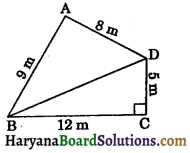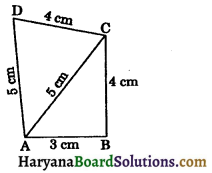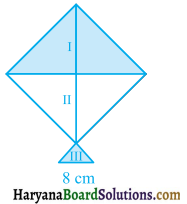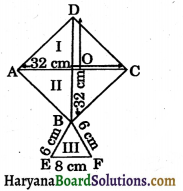Haryana State Board HBSE 9th Class Maths Solutions Chapter 12 Heron’s Formula Ex 12.2 Textbook Exercise Questions and Answers.
Haryana Board 9th Class Maths Solutions Chapter 12 Heron’s Formula Exercise 12.2
Question 1.
A parks, in the shape of a quadrilateral ABCD has ∠C = 90°, AB = 9 m, BC = 12 m, CD = 5 m and AD = 8 m. How much area does it occupy?
Solution:
In right ΔBCD, we have
BD2 = BC2 + CD2
(By Pythagoras theorem)
⇒ BD2 = 122 + 52
⇒ BD2 = 144 + 25
⇒ BD2 = 169
⇒ BD = \(\sqrt{169}\)
⇒ BD = 13 m

Area of ΔBCD = \(\frac{1}{2}\) × BC × CD
= \(\frac{1}{2}\) × 12 × 5
= 30 m2
In ΔABD, we have
AB = 9 m, AD = 8 m and BD = 13 m
So, a = 9 m, b = 8 m and c = 13 m
∴ s = \(\frac{a+b+c}{2}\)
s = \(\frac{9+8+13}{2}\)
s = \(\frac{30}{2}\) = 15 m
By Heron’s formula, we have
Area of ΔABD = \(\sqrt{s(s-a)(s-b)(s-c)}\)
= \(\sqrt{15(15-9)(15-8)(15-13)}\)
= \(\sqrt{15 \times 6 \times 7 \times 2}\)
= \(\sqrt{3 \times 5 \times 3 \times 2 \times 7 \times 2}\)
= 2 × 3\(\sqrt{35}\) = 6 × 5.916
= 35.5 m2 (approx.)
area of quadrilateral ABCD = area of ΔBCD + area of ΔABD
= 30 + 35.5
= 65.5 m2 (approx.)
Hence, area of quadrilateral ABCD = 65.5 m2 (approx.).
![]()
Question 2.
Find the area of a quadrilateral ABCD in which AB = 3 cm, BC = 4 cm, CD = 4 cm, DA = 5 cm and AC = 5 cm.
Solution:
The sides of ΔABC are a = 3 cm, b = 4 cm and c = 5 cm.
s = \(\frac{a+b+c}{2}\)
s = \(\frac{3+4+5}{2}\)
s = \(\frac{12}{2}\) = 6 cm

By Heron’s formula, we have
Area of ΔABC = \(\sqrt{s(s-a)(s-b)(s-c)}\)
= \(\sqrt{6(6-3)(6-4)(6-5)}\)
= \(\sqrt{6 \times 3 \times 2 \times 1}\)
= \(\sqrt{2 \times 3 \times 3 \times 2 \times 1}\)
= 2 × 3 = 6 cm2
The sides of a triangle ACD are
a= 5 cm, b = 4 cm and c = 5 cm
s = \(\frac{a+b+c}{2}\)
s = \(\frac{5+4+5}{2}\)
s = \(\frac{14}{2}\) = 7 cm
By Heron’s formula
Area of ΔACD = \(\sqrt{s(s-a)(s-b)(s-c)}\)
= \(\sqrt{7(7-5)(7-4)(7-5)}\)
= \(\sqrt{7 \times 2 \times 3 \times 2}\) = 2\(\sqrt{21}\)
= 2 × 4.58 = 9.16 cm2
= 9.2 cm2
Area of quadrilateral ABCD = Area of ΔABC + Area of ΔACD
= 6 + 9.2
= 15.2 cm2 (approx.)
Hence, area of quadrilateral ABCD = 15.2 cm2 (approx.).
Question 3.
Radha made a picture of an aeroplane with coloured paper as shown in Fig. 12.15. Find the total area of the paper used.

Solution:
There are five parts in the picture of an aeroplane.
The part I is the shape of a triangle. Sides of this triangle are
a = 5 cm, b = 5 cm and c = 1 cm
s = \(\frac{a+b+c}{2}\)
s = \(\frac{5+5+1}{2}\)
s = \(\frac{11}{2}\) = 5.5 cm
By Herous formula, we have
Area of part I = \(\sqrt{s(s-a)(s-b)(s-c)}\)
= \(\sqrt{5.5(5.5-5)(5.5-5)(5.5-1)}\)
= \(\sqrt{5.5 \times 0.5 \times 0.5 \times 4.5}\)
= \(\sqrt{11 \times 0.5 \times 0.5 \times 0.5 \times 3 \times 3 \times 0.5}\)
= 0.5 × 0.5 × 3\(\sqrt{11}\)
= 0.75 × 3.32
= 2.49 cm2
Part II is the shape of rectangle.
Dimensions of the rectangle are
Length = 6.5 cm and Breadth = 1 cm
Area of part II = Length × Breadth
= 6.5 × 1
= 6.5 cm2
Part III is in the shape of trapezium as shown in figure.
Draw CE || AD and CF ⊥ EB.
∴ CE = AD = 1 cm,
AE = CD = 1 cm
∴ EB = AB – AE
⇒ EB = 2 – 1 = 1 cm

So, ΔCEB is an equilateral triangle.
Area of ΔCEB = \(\frac{\sqrt{3}}{4} \times(1)^2\)
= \(\frac{\sqrt{3}}{4}\) cm2
Again,
area of ΔCEB = \(\frac{1}{2}\) × EB × CF
\(\frac{\sqrt{3}}{4}\) = \(\frac{1}{2}\) × 1 × CF
\(\frac{2 \sqrt{3}}{4}\) = CF
CF = \(\frac{\sqrt{3}}{2}\)
∴ Area of trapezium (part III) = \(\frac{1}{2}\) (sum of parallel sides) × distance between them
= \(\frac{1}{2}(2+1) \times \frac{\sqrt{3}}{2}\)
= \(\frac{3 \sqrt{3}}{4}\)
= 1.299 cm2 = 1.30 cm2
Part IV is the shape of right triangle.
Sides of this triangle are
Base = 1.5 cm and height = 6 cm
∴ Area of right triangle = \(\frac{1}{2}\) × base × height
⇒ Area of part IV = \(\frac{1}{2}\) × 1.5 × 6
= 4.5 cm2
Part V is in the shape of right triangle.
Sides of part V are same as part IV.
So, area of part V = 4.5 cm2
Total area of paper used = Area of part I + Area of part II + Area of part III + Area of part IV + Area of part V
= 2.49 + 6.5 + 1.30 + 4.5 +4.5
= 19.29 cm2
= 19.30 cm2
Hence, total area of paper used = 19.30 cm2 (approx.)
![]()
Question 4.
A triangle and a parallelogram have the same base and the same area. If the sides of the triangle are 26 cm, 28 cm and 30 cm and the parallelogram stands on the base 28 cm, find the height of the parallelogram.
Solution:
Sides of the triangle are
∴ a = 26 cm, b = 28 cm and c = 30 cm
s = \(\frac{a+b+c}{2}\)
⇒ s = \(\frac{26+28+30}{2}\)
⇒ s = \(\frac{84}{2}\) = 42 cm
By Heron’s formula, we have
Area of the triangle = \(\sqrt{s(s-a)(s-b)(s-c)}\)
= \(\sqrt{42(42-26)(42-28)(42-30)}\)
= \(\sqrt{42 \times 16 \times 14 \times 12}\)
= \(\sqrt{2 \times 3 \times 7 \times 4 \times 4 \times 2 \times 7 \times 2 \times 2 \times 3}\)
= 2 × 2 × 3 × 4 × 7
= 336 cm2
Base of parallelogram = 28 cm
Since,area of parallelogram = area of triangle, (given)
⇒ base × height = 336
⇒ 28 × height = 336
height = \(\frac{336}{28}\)
height = 12 cm
Hence, height of the parallelogram = 12 cm.
Question 5.
A rhombus shaped field has green grass for 18 cows to graze. If each side of the rhombus is 30 m and its longer diagonal is 48 m, how much area of grass field will each cow be getting?
Solution:
Each side of rhombus shaped field = 30 m.
We know that diagonals of a rhombus bisect each other at right angle.
∴ BO = OD
Let BO = OD = x m
and AO = OC = \(\frac{48}{2}\) = 24 m
In right triangle AOB, we have
AB2 = AO2 + OB2
(By Pythagoras theorem)

302 = 242 + x2
⇒ 302 – 242 = x2
⇒ (30 + 24) (30 – 24) = x2
⇒ 54 × 6 = x2
⇒ 324 = x2
⇒ x = \(\sqrt{324}\)
⇒ x = 18 m
So, BD = 2 × 18 = 36 m
Area of rhombus ABCD = \(\frac{1}{2}\) × Product of diagonals
= \(\frac{1}{2}\) × 48 × 36
= 864 m2
∵ 18 cows graze the area = 864 m2
∴ 1 cow grazes the area = \(\frac{864}{18}\) = 48 m2
Hence, each cow grazes the area = 48 m2.
![]()
Question 6.
An umbrella is made by stitching 10 triangular pieces of cloth of two different colours (see Fig. 12.16), each piece measuring 20 cm, 50 cm and 50 cm. How much cloth of each colour is required for the umbrella?

Solution:
Sides of the triangular piece are
a= 50 cm, b = 50 cm and c = 20 cm
s = \(\frac{a+b+c}{2}\)
⇒ s = \(\frac{50+50+20}{2}\)
⇒ s = \(\frac{120}{2}\) = 60 cm
By Heron’s formula, we have
Area of 1 triangular piece = \(\sqrt{s(s-a)(s-b)(s-c)}\)
= \(\sqrt{60(60-50)(60-50)(60-20)}\)
= \(\sqrt{60 \times 10 \times 10 \times 40}\)
= \(\sqrt{20 \times 3 \times 10 \times 10 \times 2 \times 20}\)
= 10 × 20\(\sqrt{6}\)
= 200\(\sqrt{3}\) cm2
Hence, area of cloth of each colour for five triangular pieces = 5 × 200\(\sqrt{6}\) = 1000\(\sqrt{6}\) cm2.
Question 7.
A kite in the shape of a square with a diagonal 32 cm and an isosceles triangle of base 8 cm and sides 6 cm each is to be made of three different shades as shown in Fig. 12.17. How much paper of each shade has been used in it?

Solution:
Since diagonals of a square are equal and bisect each other at right angle. Therefore,
AO = OC = OB = OD
\(\frac{32}{2}\) = 16 cm
Area of part I = \(\frac{1}{2}\) base × height
= \(\frac{1}{2}\) × AC × OD
\(\frac{1}{2}\) × 32 × 16 = 256 cm2

Similarly,
area of part II = 256 cm2
Sides of the part III (ΔBEF) are
a = 6 cm, b = 6 cm and c = 8 cm
⇒ s = \(\frac{6+6+8}{2}\),
= \(\frac{20}{2}\) = 10 cm
By Heron’s formula, we have
Area of part III (ΔBER)
= \(\sqrt{s(s-a)(s-b)(s-c)}\)
= \(\sqrt{10(10-6)(10-6)(10-8)}\)
= \(\sqrt{10 \times 4 \times 4 \times 2}\)
= \(\sqrt{2 \times 5 \times 4 \times 4 \times 2}\)
= 2 × 4\(\sqrt{5}\) = 8\(\sqrt{5}\)
= 8 × 2.24 = 17.92 cm2
Hence, paper used in parts I, II and III = 256 cm2, 256 cm2 and 17.92 cm2.
![]()
Question 8.
A floral design on a floor is made up of 16 tiles which are triangular, the sides of the triangle being 9 cm, 28 cm and 35 cm (see Fig. 12.18). Find the cost of polishing the tiles at the rate of 50 paisa per cm2.

Solution:
Lengths of the sides of a tile are
a = 28 cm, b = 9 cm and c = 35 cm
⇒ s = \(\frac{a+b+c}{2}\)
⇒ s = \(\frac{28+9+35}{2}\)
⇒ s = \(\frac{72}{2}\) = 36 cm
By Heron’s formula, we have
Area of 1 triangular tile = \(\sqrt{s(s-a)(s-b)(s-c)}\)
= \(\sqrt{36(36-28)(36-9)(36-35)}\)
= \(\sqrt{36 \times 8 \times 27 \times 1}\)
= \(\sqrt{6 \times 6 \times 2 \times 2 \times 2 \times 3 \times 3 \times 3}\)
= 2 × 3 × 6\(\sqrt{6}\)
= 36\(\sqrt{6}\)
Area of 16 triangular tiles = 16 × 36\(\sqrt{6}\)
= 1410.91 cm2
Cost of polishing the tiles at the rate of 50 paisa i.e., Rs. \(\frac{1}{2}\) per cm2
= 1410.91 × \(\frac{1}{2}\)
= Rs. 705.45
Hence, cost of polishing of the tiles = Rs. 705.45.
Question 9.
A field is in the shape of a trapezium whose parallel sides are 25 m and 10 m. The nonparallel sides are 14 m and 13 m. Find the area of the field.
Solution:
Through vertex C draw CE || AD intersecting AB at E. Draw CF ⊥ EB.
∵ AE || CD and AD || CE
∴ AECD is a parallelogram.
CE = AD = 14 m
AE = CD = 10 m
BE = AB – AE
BE = 25 – 10 = 15 m
Sides of the ΔCEB are
a = 14 m, b = 13 m and c = 15 m
s = \(\frac{a+b+c}{2}\)
⇒ s = \(\frac{14+13+15}{2}\)
⇒ s = \(\frac{42}{2}\)
⇒ s = 21 m
By Heron’s formula, we have
area of ΔCEB = \(\sqrt{s(s-a)(s-b)(s-c)}\)
= \(\sqrt{21(21-14)(21-13)(21-15)}\)
= \(\sqrt{21 \times 7 \times 8 \times 6}\)
= \(\sqrt{3 \times 7 \times 7 \times 2 \times 2 \times 2 \times 2 \times 3}\)
= 2 × 2 × 3 × 7
= 84 m2
Again, area of ΔCEB = \(\frac{1}{2}\) × base × height
84 = \(\frac{1}{2}\) × BE × CF
84 = \(\frac{1}{2}\) × 15 × CF
\(\frac{84 \times 2}{15}\) = CF
\(\frac{56}{5}\) = CF
CF = \(\frac{56}{5}\) cm
Now, area of trapezium ABCD = \(\frac{1}{2}\) (sum of parallel sides) × distance between them
= \(\frac{1}{2}\)(25 + 10) × \(\frac{56}{5}\)
= \(\frac{35}{2} \times \frac{56}{5}\)
= 7 × 28
= 196 m2
Hence, area of trapezium ABCD = 196 m2.